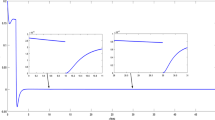Abstract
In this paper, we formulate a new system, named by sandwich control system with impulse time windows. The present system is a cyclic control system, composed of three parts in a round: the first and last parts are continuous subsystems, while the middle one includes an impulsive operation. Different from the most existing results for impulsive systems, we assume that the impulse moments are unknown but limited to certain intervals (namely, impulse time windows). We then study the stability of the considered systems and obtain an exponential stability criterion in terms of a set of linear matrix inequalities. As a numerical example, Chua oscillator is stabilized by the proposed method.




Similar content being viewed by others
References
Yin S, Shi P, Yang H (2016) Adaptive fuzzy control of strict-feedback nonlinear time-delay systems with unmodeled dynamics. IEEE Trans Cybern 46(8):1926–1938
Yin S, Yu H, Shanazi R, Haghani A (2016) Fuzzy adaptive tracking control of constrained nonlinear switched stochastic pure-feedback systems. IEEE Trans Cybern PP(99). doi:10.1109/TCYB.2016.2521179
Yin S, Zhu X, Qiu J, Gao H (2016) State estimation in nonlinear system using sequential evolutionary filter. IEEE Trans Ind Electron 63(6):3786–3794
Yin S, Wang G, Gao H (2015) Data-driven process monitoring based on modified orthogonal projections to latent structures. IEEE Trans Control Syst Technol 24(4):1480–1487
Yin S, Xie X, Lam J, Cheung KC, Gao H (2015) An improved incremental learning approach for KPI prognosis of dynamic fuel cell system. IEEE Trans Cybern PP(99). doi:10.1109/TCYB.2015.2498194
Wang X, Dong L, Yan J (2012) Maximum ambiguity based sample selection in fuzzy decision tree induction. IEEE Trans Knowl Data Eng 24(8):1491–1505
Wang X, Dong C (2009) Improving generalization of fuzzy if-then rules by maximizing fuzzy entropy. IEEE Trans Fuzzy Syst 17(3):556–567
Wang X, Yeung DS, Tsang ECC (2001) A comparative study on heuristic algorithms for generating fuzzy decision trees. IEEE Trans Syst Man Cybern Part B: Cybern 31(2):215–226
Yeung DS, Wang X, Tsang ECC (2004) Handling interaction in fuzzy production rule reasoning. IEEE Trans Syst Man Cybern Part B Cybern 34(5):1979–1987
Tsang ECC, Wang X, Yeung DS (2000) Improving learning accuracy of fuzzy decision trees by hybrid neural networks. IEEE Trans Fuzzy Syst 8(5):601–614
Yang T (2001) Impulsive control theory. Springer, Berlin
Yang T (1999) Impulsive control. IEEE Trans Autom Control 44(5):1081–1083
Yang T, Chua LO (1997) Impulsive stabilization for control and synchronization of chaotic systems: theory and application to secure communication. IEEE Trans Circuits Syst I: Fundam Theory Appl 44(10):976–988
Yang Z, Xu D (2007) Stability analysis and design of impulsive control systems with time delay. IEEE Trans Autom Control 52(8):1448–1454
Allerhand LI, Shaked U (2013) Robust state-dependent switching of linear systems with dwell time. IEEE Trans Autom Control 58(4):994–1001
Geromel JC, Deaecto GS, Daafouz J (2013) Suboptimal switching control consistency analysis for switched linear systems. IEEE Trans Autom Control 58(7):1857–1861
Heertjes MF, Sahin IH, van de Wouw N, Heemels WPMH (2013) Switching control in vibration isolation systems. IEEE Trans Control Syst Technol 21(3):626–635
Neamtu A, Stoica A (2013) A comparison of adaptive supervisory switching control schemes for high maneuverability aircrafts. Adv Intell Control Syst Comput Sci 187:157–176
Ruby T, Rehbock V (2005) Numerical solutions of optimal switching. Control Probl Optim Control Appl Appl Optim 96:447–459
Zheng G, Ma B (2012) A time optimal control problem of some linear switching controlled ordinary differential equations. Adv Differ Equ 2012:52. Open Access Date: 23 Apr 2012
Thanh T, Ahn K (2007) Control of two-axis pneumatic artificial muscle manipulator with a new phase plane switching control method. J Mech Sci Technol 21(7):1018–1027
Sanchez EN, Perez JP (1999) Input-to-state stability (ISS) analysis for dynamic NN. IEEE Trans Circuits Syst I Regul Pap 46(11):1395–1398
Boyd S, Ghaoui L, Feron EEI, Balakrishnan V (1994) Linear matrix inequalities in system and control theory. SIAM, Philadelphia
Shilnikov L (1994) Chua’s circuit: rigorous results and future problems. Int J Bifurc Chaos 4(3):489–519
Acknowledgments
This research is supported by the Natural Science Foundation of China (Grant No. 61374078), NPRP Grant # NPRP 4-1162-1-181 from the Qatar National Research Fund (a member of Qatar Foundation), Scientific and Technological Research Foundation of Chongqing Municipal Education Commission (Grant No. KJ1401010), the Fundamental Research Funds for the Central Universities (Grant No. XDJK2015D004) and Key Program of Chongqing Three Gorges University (Grant No. 14ZD18).
Author information
Authors and Affiliations
Corresponding author
Ethics declarations
Conflict of interest
The authors declare that they have no competing interests.
Authors’ contributions
C. Li has proposed the ideal of sandwich control. Y. Feng has proved the main theory and prepared the paper with latex. T. Huang has provided all the figures of the paper. All authors read and approved the final manuscript.
Rights and permissions
About this article
Cite this article
Feng, Y., Li, C. & Huang, T. Sandwich control systems with impulse time windows. Int. J. Mach. Learn. & Cyber. 8, 2009–2015 (2017). https://doi.org/10.1007/s13042-016-0580-5
Received:
Accepted:
Published:
Issue Date:
DOI: https://doi.org/10.1007/s13042-016-0580-5




